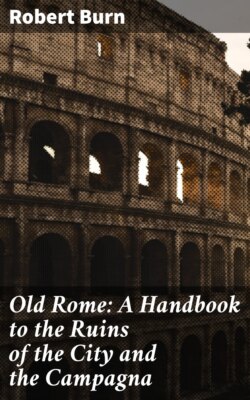Читать книгу Old Rome: A Handbook to the Ruins of the City and the Campagna - Burn Robert - Страница 3
На сайте Литреса книга снята с продажи.
PREFACE.
ОглавлениеTable of Contents
This book is intended to serve as a handbook to the actually-existing ruins and monuments of ancient Rome and the Campagna. It is divided into topographical sections for the convenience of travellers visiting Rome, and the monuments which exist in each section have been briefly described, and a summary given of their history and archæological value.
The introductory section contains general remarks upon the site, monumental history, and architecture of Rome; and in a section prefixed to Chapter IX. the nature of the soil and configuration of the hills and valleys of the district surrounding the city are stated.
In the Appendix to the eighth chapter will be found a list of the chief monumental antiquities in the museums, galleries, and other public places. This has been thought to be useful, as these are often difficult to recognise from being mixed with so many other attractive and important objects of more modern art and history. All speculative conjectures as to the probable sites or constructions of ancient buildings or places have been avoided. Such questions require more space than can be spared in so small a volume, and have been fully treated of in my larger work, “Rome and the Campagna.”
I have confined myself in this handbook to a brief topographical, archæological, and historical description of each existing ruin or monument. The references given have been restricted to modern treatises and to a few of the more rarely read Greek and Latin authors. Full classical authorities are given in “Rome and the Campagna,” and are referred to in the foot-notes of this handbook.
The importance of topographical and archæological knowledge, in enabling us to realise the history of ancient life, both national and social, is fortunately becoming more and more generally recognised. The early growth and characteristic features of the Roman commonwealth can be traced in great measure to the conformation of the ground on which the community was first developed. Such local influences are among the highest and most philosophical parts of historical investigation, and have a most important value in enabling us to form an estimate of the truth of statements made by the ancient writers of history.
Besides this interest which pervades the early stage of Roman history, there is also a natural connection, by way of cause or explanation, between the events of later times and the localities in which they occurred; and this in social as well as in national history. Many Roman customs and usages, now extinct, are illustrated and realised by the knowledge gained from monuments of ancient architecture and art. And again, the spirit of Roman literature is more fully sympathised with, and its difficult passages and allusions are frequently elucidated by the light of archæological knowledge.
Thus there is not only the poetical and imaginative satisfaction, which is usually felt most vividly in treading the soil, surveying the scenes, and breathing the air in which great historical persons lived and events occurred, but also an element of fact which gives a firm basis of incontestable truth to our knowledge, and which no speculative interpretation can dissolve.
It is hoped, therefore, that even such an abridged description of ruins, and such a summary of archæological results as that which forms the basis of the present volume, will not be without use to the student of history, as well as a guide to the traveller.
In the chapter on the ruins of the Campagna I have inserted some statements on the geological formations, and on the climate, which appear to have influenced the history and the architecture of that district.
The books from which useful information has been derived are, in addition to those mentioned in the list given in “Rome and the Campagna,” some of the later numbers of “Annali dell’ Instituto,” a small treatise called “Guida del Palatino,” by C. L. Visconti and R. A. Lanciani, and “A Topographical Study of the Roman Forum,” by Mr. F. M. Nichols.
Robert Burn.
Cambridge.
Sept. 24, 1879.
